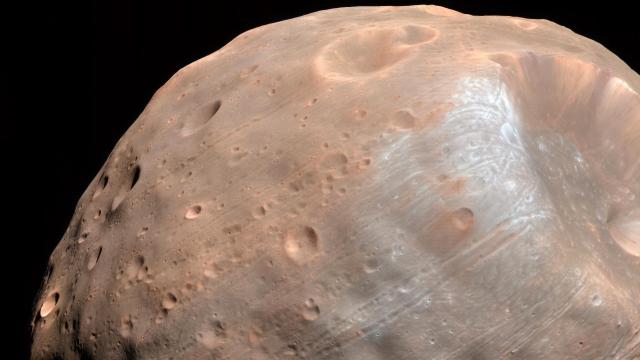New research offers an explanation for the unusual orbit of Mars’ moon Deimos, one that bolsters the hypothesis that the Red Planet periodically features a Saturn-like ring.
Mars has two very ugly moons, Phobos and Deimos. In addition to their potato-like appearance, both moons have exceptionally circular orbits aligned above Mars’s equatorial plane. Actually, that’s not entirely accurate, as Deimos, the outer of the two moons, sits slightly outside this plane.
As it turns out, this slight, two-degree difference is more important than we realised, according to new research presented this week at the 236th meeting of the American Astronomical Society, which was held virtually this year. You can read the pre-print here; the paper was accepted for publication in a future edition of Astrophysical Journal Letters.
“The fact that Deimos’s orbit is not exactly in plane with Mars’s equator was considered unimportant, and nobody cared to try to explain it,” said Matija Ćuk, the lead author of the new study and a research scientist at the SETI Institute, in a press release. “But once we had a big new idea and we looked at it with new eyes, Deimos’s orbital tilt revealed its big secret.”
That big secret actually has to do with Phobos, the other Martian moon. As the new study suggests, Phobos is caught in a cycle of death and rebirth that temporarily and periodically results in rings around the Red Planet. This theory was actually posited in 2017 by David Minton, a professor at Purdue University and a co-author of the new study, and Andrew Hesselbrock, his grad student at the time.
The cyclic moon theory, as it’s called, is an attempt to figure out how Mars got its two moons. Various theories have attempted — and failed — to explain how these small, misshapen moons ended up in their current orbital configurations. Popular theories include captured asteroids or a collision between two objects, yet these solutions fall short in explaining the moons’ super-circular, equatorial orbits and Deimos’s odd tilt.
This is where the cyclic moon theory comes in. As the 2017 paper pointed out, Phobos is slowly sinking toward Mars. Eventually, in around 70 million years, Mars’s gravitational tug will be too much to bear and Phobos will disintegrate, resulting in a new Martian ring. This ring will eventually spawn a brand new, substantially smaller moon. This has happened between three and seven times over the past 4.3 billion years, according to Minton and Hesselbrock.
So what has all this got to do with Deimos? Well, Deimos wouldn’t be slightly off its equatorial kilter if it were not for an event much like this, according to the new study.
Using computer simulations, Ćuk and his colleagues showed that the birth of a large Phobos-like moon — one 20 times larger than the current Phobos — would’ve had a noticeable effect on Deimos’s orbital inclination. As the models showed, the newly birthed moon, pushed outward by the Martian ring, would eventually achieve a 3:1 orbital resonance with Deimos (in which the new moon’s orbital period is exactly three times shorter than Deimos’s orbital period). This in turn resulted in the currently observed two-degree tilt.
“This cyclic Martian moon theory has one crucial element that makes Deimos’s tilt possible: a newborn moon would move away from the ring and Mars,” according to the SETI press release. “Which is in the opposite direction from the inward spiral Phobos is experiencing due to gravitational interactions with Mars.”
This should have happened, not during the birth of Phobos’s parent moon, but during the birth of its grandparent moon some 3 billion years ago. The age of the two objects jibes nicely with this story, as Deimos is billions of years old while Phobos (the current version) is just 200 million years old.
These results are from computer models, so they need to be approached with caution. Thankfully, there’s an upcoming JAXA mission, called Martian Moons Exploration, in which a spacecraft will explore both moons and even bring a sample of Phobos back to Earth. This mission will undoubtedly provide further details about these moons and their elusive origin stories.
As Ćuk said in the SETI press release, “I do theoretical calculations for a living, and they are good, but getting them tested against the real world now and then is even better.”
